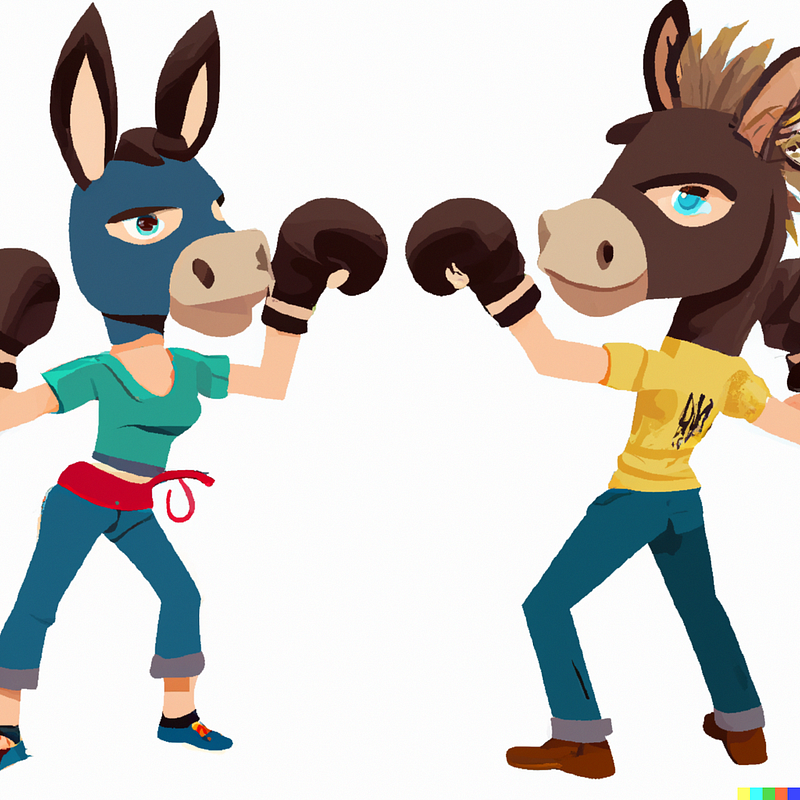The Myth of Fragility
Relying too much on physical strength reveals metaphysical fragility


Boxing — as a sport — consistently fails to capture my attention. I don’t want to watch people get punched in the face; I don’t want to engage in punching other people in the face. (At least one person is out there thinking “Right, Amethysta, because if you got punched in the face, it would mess up your eyeliner and ruin your day.” Not inaccurate.)
Western society appreciates people willing to take a punch in the face — literally or figuratively. The explicit rules of strength are “no pain, no gain,” “boys don’t cry,” “never let them see you sweat.” And so on, until the only role models our children have are unrealistic façades of action heroes and business moguls.
Hollywood delights in knocking down a superhero for him to rise from the rubble — battered and bloody — for one final showdown of punching the Bad Guy in the face.
I was not taught about inner strength as a child. I was taught the bigger man was the better man — and he would push me down to prove it, if necessary.
Unfortunately, I was taught foolishness.
Some people — believing themselves to be the bigger man — delight in knocking others down, perhaps engaging in physical violence against them in the hopes they do not rise from the rubble. But these people are not the better man.
Life is not one long string of physical tests. Being true to oneself — standing firm in our identity against society’s expectations and disapproval — requires a different kind of strength, the kind that doesn’t end with anybody’s face being punched.
The strength of Greek and Roman athletes
Western society’s fascination with physical strength has a long history. The ancient Greek Olympic Games had few restraints on athletes outside biting, gouging eyes, and punching genitals — and breaking those rules resulted in corporal punishment.
Games included boxing, long jump, discus, wrestling, and distance running. Although it was possible for an athlete to surrender when he realized he was beaten, most would not to preserve their honor. Many athletes died — and these were the Good Guys!
Ancient Romans took games to a new level. Instead of just Good Guys competing for glory, the Romans entertained themselves by forcing criminals, war hostages, and the insane to fight each other to the death.
The Colosseum in Rome is still the largest amphitheatre in the world — purported to have held as many as 87,000 people — in which the entire population of Santa Barbara, CA, could turn out for a bloody good time on a Sunday afternoon.
Both Greek and Roman cultures valued physical strength — in their gods and in their society. Obviously, philosophers, scientists, and politicians also played a significant role in perpetuating Greek and Roman culture, but the definition of “strength” revolved around being able to defeat others in battle.
But was ancient history all about physical strength? Were all conflicts resolved by strapping on a sword and striding into an arena? Roman historians would have us believe that — it was, after all, the Roman way to storm into new areas with a legion. Historians then justified the conquest by calling the people who lived there first “barbarians” or “savages.” The Romans did their new subjects a favor by bringing civilization…and the honor of joining the legion to conquer the next territory.
Ancient history sounds awfully familiar…
Modern judo practitioners
The modern Olympic Games included a new sport in 1964: judo. Judo differs from other forms of martial arts by focusing on subduing an opponent without striking him. Although judo is fascinating in itself, I do not intend to discuss it in depth. Rather, I want to focus on one of the first practitioners of judo in Europe — Moshé Feldenkrais.
Feldenkrais was a physicist who turned his attention from nuclear chemistry to the posture and movement of the human body. As judo seeks to subdue opponents as efficiently as possible — preferably using the opponent’s own movement against him — Feldenkrais sought balance in human anatomy to encourage movement as efficiently as possible.
Feldenkrais modeled a human body as three stacked, inverted pyramids: feet to hips, spine to shoulders, and neck to top of head. Despite the inherent thermodynamic instability of one inverted pyramid, let alone three of them stacked, the structure of the human body is such that it may achieve stability — as long as we allow it to operate the way it is designed.
Instability in the body is caused not by lack of muscular strength, but by lack of muscular coordination. When we understand and feel our bodies, no movement is a test of physical fitness (although participants in a Feldenkrais session know the physical work necessary to achieve the understanding).
Strength versus flexibility
If the human body is capable of stability and efficiency with a Feldenkrais body as opposed to a Schwarzenegger body, is physical strength critical to survival? A story found in many forms and in many cultures contrasts strength with flexibility.
Physical strength is likened to solidity, to a brick wall, an oak tree, a Roman Gladiator. When pushed, strength pushes back. When punched, strength punches back. In a hurricane, strength leans into the wind and laughs.
Flexibility is likened to movement, to a floating dock, a willow tree, a judo practitioner. When pushed, flexibility steps aside to avoid the force. When punched, flexibility grabs the arm and pulls. In a hurricane, flexibility moves with the wind instead of fighting it.
Sometimes, pushing back fails. Laughing in the face of adversity fails. Sometimes, the ability to regroup, to adjust, and to adapt is the key to long-term survival. We see this exemplified in human evolution.
A stronger identity
Living in society entails conflict. There is no unlimited resource on Earth; humans must decide how to utilize resources as equitably as possible for sustainability. But conflict does not need to be a test of strength against strength.
Many of us face ongoing persecution — the transgender community has seen more than its share recently. The answer to this persecution is not a concealed weapons license. It is not to take the fight to those who initiated it unprovoked. But the answer also is not to live in fear and to die unfulfilled.
Our highest purpose as humans is to discover who we are, to live as ourselves, to inspire the next generation to live as they are as well. There are those out there who will use physical force against us, to attempt to strike us from history, to silence us, and to send us into hiding.
I cannot comply.
After 52 years of masking myself, I unleashed who I am. Now I must live as I am and die if I must in proof of my identity. I am not an oak tree or a brick wall. I accept that I must bend, that I must concede, that I must adapt — but I must persist.
Living as I am tells the Myth of Fragility — I am the heroine to scream a collective “fuck you!” to the gods of strength who would destroy me. Despite their muscles, despite their weapons, despite their lightning bolts of cleansing, I will live on — in hearts and minds, if not in body.
Do you hear me, ye gods?
I cannot be destroyed.




